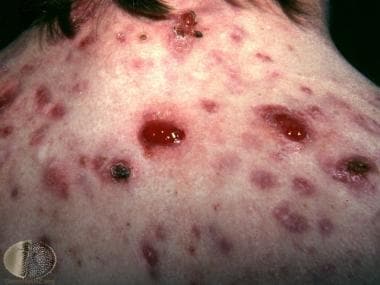Practice Essentials
Acne fulminans, also known as acne maligna, was originally described as acute febrile ulcerative acne conglobata. [1, 2] Since 1958, when Burns and Colville presented the case of a 16-year-old White boy with acute febrile disease and acne conglobata at a meeting of the Detroit Dermatological Society, many similar cases have been reported.
The primary features of acne fulminans include sudden onset, severe and often ulcerating acne, fever, polyarthritis, and failure to respond to antibacterial therapy; the response to debridement in combination with steroid therapy is good. Acne fulminans is a syndrome of fulminant, necrotizing acne associated with bone lesions, constitutional symptoms, and laboratory abnormalities. (See the image below.) It can be the dermatologic manifestation of the SAPHO (synovitis, acne, pustulosis, hyperostosis, osteitis) syndrome. [3] Acne fulminans may also be seen together with hidradenitis suppurativa, in what may be a newer phenotypic entity. [4]
 Granulomas and crusted acne lesions in acne fulminans. Image from DermNet New Zealand (https://www.dermnetnz.org/assets/Uploads/doctors/follicular/images/fulmin2.jpg).
Granulomas and crusted acne lesions in acne fulminans. Image from DermNet New Zealand (https://www.dermnetnz.org/assets/Uploads/doctors/follicular/images/fulmin2.jpg).
For complete information on related conditions, see Acne Conglobata, Acne Keloidalis Nuchae, Acne Vulgaris, and Acneiform Eruptions.
Pathophysiology
Acne fulminans is an uncommon immunologically induced systemic disease characterized by aggressive inflammation, in which the triggering antigen is believed to be from Cutibacterium acnes (formerly Propionibacterium acnes); it is a severe variant of acne vulgaris.
Some authors have noted that elevated blood levels of testosterone may play an important role in the pathogenesis of acne fulminans. High levels of testosterone and anabolic steroids cause increases in sebum excretion and in the population density of C acnes. In one report, anabolic steroid use induced acne fulminans in a male bodybuilder. [5] Testosterone therapy seemed to trigger acne induction in a transgender boy [6] and in a patient with Marfan syndrome. [7] An increase in the amount of C acnes or related antigens may trigger the immunologic reaction in some individuals and lead to an occurrence of acne fulminans. [8]
In addition to testosterone, isotretinoin may also precipitate acne fulminans, possibly as a consequence of highly increased levels of C acnes antigens in the patient's immune system. [9, 10]
Another theory that has been proposed postulates that acne fulminans may be an autoimmune complex disease, because circulating immune complexes have been demonstrated in some patients with acne fulminans. Immunologically, the reaction is a type III or IV hypersensitivity reaction.
Genetic factors may play an important role in some patients; a study by Palatski et al documented four sets of identical twins who developed an identical pattern of acne fulminans. [11]
Acne may be the only clinical sign of androgen excess in men. One report decribed a boy with acne fulminans and androgen excess due to late-onset congenital adrenal hyperplasia. [12]
Acne fulminans has also been observed in patients with measles infection. [13]
Chronic inflammation in acne fulminans, characteristic of acne lesions, can also be accompanied by angiogenesis. Through specific immunostaining for CD34+ endothelial cells, research revealed the presence of blood capillaries around the pilosebaceous follicles within the inflammatory or pericystic infiltrate. [14]
A case report described a 13-year-old patient who developed acne fulminans after treatment with isotretinoin 0.1 mg/kg/day, without associated systemic symptoms. [15]
Consensus recommendations on classification
In 2017, a panel of experts made the recommendation that acne fulminans be classified into four distinct clinical variants,as follows [16] :
-
Acne fulminans with systemic symptoms (AF-SS)
-
Acne fulminans without systemic symptoms (AF-WOSS)
-
Isotretinoin-induced acne fulminans with systemic symptoms (IIAF-SS)
-
Isotretinoin-induced acne fulminans without systemic symptoms (IIAF-WOSS)
Epidemiology
Acne fulminans is a rare disease. Over the past decade, fewer cases of this disease have occurred, possibly because of earlier and better treatment of acne. Approximately 200 patients with acne fulminans have been described. [17, 18, 15]
Acne fulminans predominantly affects young males aged 13-22 years with a history of acne.
Prognosis
Recurrent acne fulminans is extremely rare. Bone lesions typically resolve with treatment, but residual radiographic changes, such as sclerosis and hyperostosis, may remain. Scarring and fibrosis may result from this acute inflammatory process.
-
Granulomas and crusted acne lesions in acne fulminans. Image from DermNet New Zealand (https://www.dermnetnz.org/assets/Uploads/doctors/follicular/images/fulmin2.jpg).

